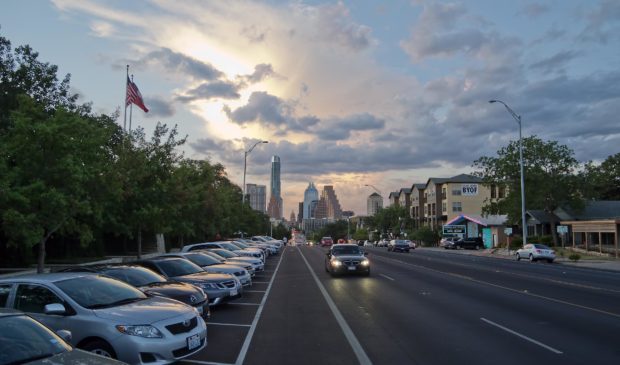Mobility Committee aims to protect streets from parking demand
Tuesday, November 12, 2019 by
Ryan Thornton Parking has been “right-sized” in the draft Land Development Code, though some members of City Council are concerned that could have the wrong effect in some parts of the city.
The code rewrite team told Council’s Mobility Committee last Tuesday that reduced parking requirements can help lower development and housing costs, grow transit ridership and generate funds for the city’s unbuilt sidewalks.
Council members Ann Kitchen and Alison Alter, however, said people are worried that fewer on-site spaces coupled with more traffic could impact conditions on the streets in some parts of the city.
The code generally waives parking requirements for sites within a quarter-mile of the transportation priority network or Imagine Austin activity centers and corridors as long as there are adequate sidewalks connecting the site and the corridor.
Besides sidewalks, Kitchen said she’s heard that some people worry bicycle facilities could be threatened by the changes. Particularly with unprotected bicycle lanes, she said, the temptation to park in bike lanes on the street could become more acute if off-street parking becomes scarce.
Kitchen also mentioned street conditions as a potentially useful factor in deciding whether a parking minimum should be required or not. She said fewer parking spaces could have more of an impact on “narrow, substandard” residential streets as demand grows for on-street parking.
Annick Beaudet, assistant director of Austin Transportation, said neither bicycle infrastructure nor the width of streets had been considered yet as contextual factors for parking requirements. In some cases, she said, on-street parking demand can actually improve street conditions by “creating friction” that slows traffic down. Even so, she said, emergency access has been a part of the discussion.
Alter, who serves on the city’s joint committee with the Austin Independent School District and Travis County, said the school district is also starting to fret over parking scarcity. Many of the schools don’t have quite enough parking for teachers, and parents rely on street parking for drop-off and pickup or attending school assemblies and events, she said.
If those schools, such as the case of Bryker Woods Elementary, are also located near a transportation priority network, waiving parking minimums in the neighborhoods could lead to more on-street parking demand and potentially dangerous situations, Alter said. In some cases, she added, they may also lack access to public transit or have limited school bus service.
At Alter’s request, Beaudet agreed to make a map overlaying the quarter-mile areas along corridors and centers with public schools for Council to consider.
While Kitchen and Alter discussed the need to preserve on-street space, Council Member Jimmy Flannigan brought up a separate issue that could create more demand for that space.
Frustrated with the amount of product loading and unloading occurring in active travel lanes, Flannigan said it may be helpful to create areas in on-street parking spaces where loading and unloading would be allowed at certain hours of the day instead of continuing to expect delivery trucks to use less-convenient designated loading zones.
“Rather than trying to force delivery drivers into a scenario that they will just ignore, maybe we should lean into exactly how that will work best so that they will actually use it,” he said. “To my mind it would be that the loading zone is right near where they are unloading and not requiring them to pull into a complicated loading area, which they’re frankly just not doing.”
Beaudet said the Transportation Department is very aware of that problem and has been looking for a way to potentially codify and manage loading in the right of way so it doesn’t endanger anyone or stop traffic flow. She said the issue will also be addressed in the draft code’s supplemental documentation that will be released Nov. 18.
The draft code has been written so that ADA-accessible parking will be more abundant in the future than under today’s code and that the city’s high and very high priority sidewalks in the Austin Strategic Mobility Plan will be completed with the help of private development.
The code offers developers a way to help build or pay for any missing sidewalks if there are any gaps between their site and the corridor, but developers would still need to provide 50 percent of the required parking spaces if any gaps remain that are not part of the high or very high priority network.
The rewrite team says this will help bridge the approximately $250 million funding gap to complete the sidewalk network.
The Pedestrian Advisory Council passed a recommendation on Nov. 4 restating its previous request to remove all parking minimums citywide “as soon as is practicable.” In the meantime, the recommendation calls for a framework to allow underused parking spaces to be converted to a more productive use.
The recommendation also objects to the 50 percent parking requirement when sidewalk gaps are still present. Instead of parking, it states, developments should have to integrate pedestrian safety improvements as part of the development review process.
Photo by David Ingram made available through a Creative Commons license.
The Austin Monitor’s work is made possible by donations from the community. Though our reporting covers donors from time to time, we are careful to keep business and editorial efforts separate while maintaining transparency. A complete list of donors is available here, and our code of ethics is explained here.
You're a community leader
And we’re honored you look to us for serious, in-depth news. You know a strong community needs local and dedicated watchdog reporting. We’re here for you and that won’t change. Now will you take the powerful next step and support our nonprofit news organization?



